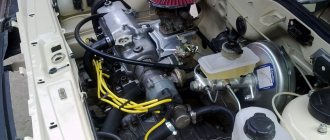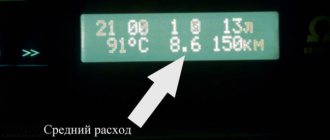A car battery does not require special care during operation, but it is necessary to periodically descale it, maintain the electrolyte level and recharge it as necessary. The charging process does not cause problems if you follow the rules specified in the instructions. A number of car owners believe that in order to charge the battery, there is no need to disconnect it from the car’s electrical circuit. For many years, debates have continued among car owners on the topic - is it possible to charge a battery without removing the terminals?
Is it possible to charge the battery without removing the terminals?
Disconnecting the terminals from the battery of a modern car can cause serious problems, such as:
- resetting the on-board computer settings;
- reset RAM;
- blocking of some systems, requiring their subsequent configuration or reinstallation.
Nobody wants to create problems for themselves every time they disconnect the terminals from the battery, therefore, the majority of car owners charge their batteries without disconnecting them. And the electronics of different brands of cars behave differently after a blackout, so it is almost impossible to foresee the consequences in advance.
If you don’t want problems with your car, remove the terminals when recharging the battery, especially since it’s not that difficult
Typically, car owners keep a backup parallel battery. Car enthusiasts who do not want to install a parallel battery and tinker with the settings charge the battery without disconnecting the terminals.
Charging the battery without removing the terminals
Is it possible to charge the battery without dismantling it - a difficult question. There is no specific answer to which. There are opinions among car owners that charging the battery without removing the terminals is completely safe, as well as opinions about the negative consequences that arise when charging without disconnecting the battery. In their opinion, a voltage surge may occur. As a result, the vehicle's electronic devices may require expensive repairs or replacement.
Using an auxiliary battery
Auto electricians recommend using the following method when dismantling the battery, which prevents the car’s electronics from being reset:
- take a 12-volt battery with a sufficient charge level that can support the car’s electronics;
- Using special wires, connect this battery in parallel to the car terminals;
- disconnect the main battery.
In the absence of the main battery, the vehicle's electronics will be “powered” by an auxiliary energy source. After charging the main battery, it can be returned back into the electrical circuit without any problems. This method is complicated by the fact that not every car owner has a spare battery and wires for connecting an auxiliary battery.
How to properly disconnect a car battery
Almost every car owner knows how to remove the battery from a car. Before dismantling, it is important to turn it off correctly; improper shutdown can have serious consequences.
During the work process, it is necessary to follow some rules and precautions. Before disconnecting the terminals from the battery, you must:
- read the instructions for the alarm, find out about its “behavior” when the car is de-energized (there is a possibility of the doors being blocked).
- turn off all electrical equipment and ignition;
- turn off the mass, if any;
Mains switch - to turn it off you just need to twist the “cap”
When the car is completely de-energized, you can remove the battery.
How to remove the battery from a car
There is a sequence for disconnecting the terminals. Regardless of the make of the car , the first terminal that is disconnected from the battery is the negative terminal . If there is no terminal designation, they can be identified by the color of the electrical wires.
- “Plus” is usually red; this is a generally accepted marking established for all car brands without exception.
- The negative contact of the battery is connected to ground. By “throwing off” the terminal from the “minus”, the battery is disconnected from the car body.
If, when disconnecting the “plus”, you drop a metal object and it hits the body or engine, there will be no short circuit, since the “battery - car” circuit is open. Next, you need to disconnect the “positive” terminal and remove the battery.
If you disconnect the “positive” terminal first and touch the body or engine of the car with a metal object, a short circuit will occur! It can damage the electronics of the car, even those that are in the off position.
A modern car is full of electronics that are constantly energized. In the event of a short circuit, it fails; in some cases, a short circuit can lead to a fire.
To avoid a short circuit, you must first remove the negative terminal from the battery.
First you need to loosen the negative, reset the wire and secure it. The wires are flexible, without fastening there is a possibility of touching the contact, which can cause a short circuit. The easiest and fastest way to secure them is with regular wire.
If, when removing the terminal between it and the battery contact, there is a spark, it means that at least one of the car’s devices is energized or there are problems with the electrical wiring on the car.
Is it possible to charge a battery in the cold?
If there is nowhere to go, then you have to charge the battery even at critically low temperatures. The success of the result in this case will directly depend on the location of the battery, which is usually located under the hood, in the trunk, or has an external mount. And most often, motorists have to resort to all sorts of tricks to restore the battery as quickly as possible: heating the house near the radiators and covering the car with tarps and blankets.
In case of prolonged inactivity, it is recommended to charge the car battery in the standard way.
Charging the battery without removing the terminals
Quite often, car owners who do not have the opportunity to install a parallel battery and who do not want to configure on-board systems charge the batteries without disconnecting the terminals.
There are a lot of opinions on the Internet, and it can be difficult to know what information is accurate. Let's try to answer whether it is possible to charge a battery connected to the car's electrical network or not. To get the most accurate answer, it’s worth understanding the physics of the charging procedure.
The main danger to which car electronics are exposed when charging a battery connected to the on-board network is overvoltage. If the maximum permissible voltage value is exceeded, the vehicle's electronics may fail, which will require subsequent replacement of burnt-out elements.
Each brand of car has its own maximum permissible voltage parameters for the electronics. A car enthusiast who plans to charge a battery without disconnecting the terminals should know the minimum maximum permissible voltage for all elements of the car’s electronics. On average, for all cars, the voltage withstand by the electronics is 15 – 16 V. Knowing the value of the maximum permissible voltage, the charging station is selected based on its output parameters.
Using a high-quality charger for charging, you can look at the parameters at the output of the device in the documentation for the equipment. Based on the output parameters, we can conclude that it is possible to charge the battery without disconnecting the terminals.
Having made a choice in favor of a low-quality charging station, there is no guarantee that information about the output parameters can be found in the documentation for it. The bulk of chargers on sale have an output voltage of about 17 - 18 V. When choosing such a device to charge the battery without disconnecting the terminals, there is a high probability of damage to the car's electronics. Most manufacturers of high-quality “chargers” equip them with surge protection.
The output voltage is usually written on the charger packaging
Choosing a charger with surge protection makes charging the battery without disconnecting the terminals completely safe for electronics. When choosing chargers from little-known manufacturers, it’s worth thinking about - most likely, it will be easier to configure the car’s electronics than to restore expensive electronic equipment.
What happens when charging a battery with the terminals attached?
Let’s conditionally divide cars into the old type with carburetors and the new type with injectors. The first type does not have an electronic control unit at all, so it cannot burn out on them. The ignition is regulated by mechanical systems that are resistant to voltage surges and are powered only when the ignition is on.
The alternator in such cars outputs voltage through a regulator relay, which prevents the battery from overcharging and regulates the voltage and current ratings. In a switched off car, when the terminals are connected to the circuit, the regulator and starter relay are turned on, which do not suffer from connection to the charger, since it produces no more than 15 V. In generators of later designs, the regulator is installed directly in the housing, on the back cover. Many of them only regulate voltage.
In injection-type cars, an electronic control unit (ECU) is added to the standard circuit, but all operating principles remain the same. With its help, the battery charging process is monitored through a sensor installed on the generator regulator. If the voltage drops below the nominal voltage, the corresponding indicator lights up on the dashboard. When the car is turned off, the sensor does not work, that is, no current flows and the ECU is excluded from the circuit through which the charging current passes.
Thus, if you connect the charger to a fuel-injected car with the engine turned off, there will be no load on the elements of its electrical system, so they cannot burn out even theoretically.
Many modern luxury cars have several ECUs, so the battery is hidden in them so that when it is disconnected, the settings are not lost, which can only be restored at the dealer. This is further confirmation that they are designed to be recharged without removing the terminals.
Safety precautions when charging a battery without removing the terminals
Only from the outside, the charging procedure seems simple, since it does not require any special actions from the car owner. In reality, charging a battery without disconnecting the terminals is far from a simple process that requires control. When charging in this way, the following safety precautions should be observed:
- the charging station is connected to the network after connecting the terminals to the battery terminals;
- upon completion of the process, the terminals from the battery are initially disconnected, and only then the charging station is turned off.
Compliance with the following operations in the specified sequence will avoid overvoltage at the output of the charging station when it is turned on and off:
- you must connect the charger starting with the “positive” wire;
- disconnect - starting from the “negative” terminal;
- prevent any of the car's electrical consumers from turning on;
- prevent contact of exposed parts of the charging wires with the car body or ground;
- Choose a ventilated area to charge the battery;
- exercise control over the charging procedure.
You can charge the battery without disconnecting it from the car only if you follow safety measures and have 100% confidence in the output parameters of the charging station.
Safety precautions when charging the battery
The key to success in absolutely all endeavors is compliance with safety measures. And charging the battery in this regard is no exception to the rule, requiring strict compliance with the following conditions:
- It is imperative to wipe the terminals and other surfaces of the battery with a dry cloth, since they must be dry and the gas channels must be open.
- If there is a deficiency of electrolyte, it must be replenished by adding distillate or using a device for automatic voltage support if the battery design does not provide a topping function. As for the density of the working fluid, it should correspond to 1.27 g/cm3 and 1.25 g/cm3.
- Do not smoke or light matches near the battery, as this may cause a fire.
- It is not allowed to charge the battery directly from the outlet, because instead you need to use a special device, and not a homemade one, but a factory one.
- Exceeding the electrolyte temperature of 45 degrees is a reason to pause the charging process, allowing time for cooling.
- The DC voltage should fluctuate in the range from 12.6 to 12.7 V, although it must be measured only a few hours after the internal combustion engine has completely stopped.
In case of prolonged inactivity, it is recommended to charge the car battery in the standard way, using boosters (starting devices) only in case of emergency.
Based on these considerations, it is strongly recommended to fully charge the vehicle before storing it for long periods of time.
The most common mistakes when charging a battery
Sometimes even experienced motorists make “classic” mistakes when charging a battery, forgetting about basic safety rules. The main ones are:
- Charging the battery at home or in an apartment. It is strictly forbidden to charge the battery in a residential area due to poor ventilation of the room and the possibility of the battery exploding.
It is not recommended to charge the battery in a residential area - Smoking or open fire near a charging battery. During the charging process, electrolyte vapors are released, which, when interacting with an open flame, can cause an explosion.
- On batteries to be serviced, the plugs must be open when charging. They must be opened before charging. Failure to comply with these measures may cause an explosion of electrolyte vapors.
Twisted battery plugs - Current too high. Selecting a current that is too high significantly reduces the life of the battery or can completely damage it.
Compliance with all these standards will increase the battery life and protect the person charging the battery and surrounding people.
Features of the car battery charging process
There are certain rules for charging batteries, compliance with which is considered a guarantee of safety, both for the motorist and the vehicle itself. According to them:
- To replenish the battery charge, it is recommended to partially dismantle it (negative terminal).
- The charge must be carried out in non-residential premises (garage, outbuildings, etc.).
It is important to remember that in cold weather the battery takes a charge much worse and professionals advise performing the procedure at a temperature range from 0 to +25 degrees Celsius.
And it is for this reason that in winter the battery restores capacity much worse directly during a trip, since the electrolyte does not have time to warm up.
- Directly during charging, harmful volatile substances are released. In addition, there is a risk of electric shock, so it is better to immediately remove rings, watches, bracelets and other metal jewelry from your hands.
If charging is carried out under conditions that do not involve removing the battery, which happens quite often, then the motorist will have to use a special device that provides reliable protection of the battery from damage.
Before starting work, all units must be turned off, since it is necessary to unload the battery as much as possible.
And if this is the case in winter, then the cooled battery must be moved for some time to a warm room and only then resort to manipulation with it.
How long does it take to charge a car battery?
There are two types of battery charging: constant current or constant voltage. For each of these types, the battery charging time may differ by an order of magnitude.
Approximately half of car owners adhere to charging the battery with direct current. Current strength is a significant characteristic, exceeding which is unacceptable, and underestimating it will make charging take a long time.
When charging, the voltage is set slightly higher than the nominal one - about 14 V. The generator produces approximately the same voltage. At a lower voltage - 11 - 12 V, charging will be in vain, and most likely will discharge the battery more.
A voltage of 10% of the battery capacity is considered normal. For example, for a capacity of 55 Ah, the battery must be charged with a current of 5.5 A. If the battery is completely discharged, it will be charged in approximately 10 hours. If the discharge is incomplete, this time may be shorter.
It is easy to determine that the battery is charged on the battery being serviced - this process is characterized by boiling of the electrolyte in the jars.
There is constant voltage charging, which is no less popular among car owners. This method is very convenient for chargers where there are no “Voltage” and “Amperage” indicators, but only indicator lamps or a scale indicating battery charge. Such chargers are designed for maintenance-free batteries. Since on such batteries you cannot visually see the process of electrolyte boiling.
When charging using this method, the voltage can vary in the range of 13.8 - 14.5 V; the higher the voltage, the faster the battery charging speed. This method is very convenient for those who do not want to “mess around” with the charger and configure it - it will do everything on its own.
The main amount of charge is taken by the battery in the first 3 – 4 hours of charging. Its capacity will be 90 - 95%. In the following hours, the current will drop to approximately 0.2 A, and charging to 100% will take the same 10 hours.
However, in general, battery charging time varies from person to person and will depend on the charger used, the type of battery and how discharged it is. On average, the charging time to 100% will be as follows:
- for a current of 10% of the nominal – 10 hours;
- for variable voltage - 4 - 5 hours to 95%, this is quite enough and 8 - 10 hours until fully charged.
How long does it take to charge properly?
The duration of the charge directly depends on the condition and capacity of the battery, as well as the recovery method used. The latter means the use of direct, alternating current and an accelerated algorithm. In most cases, motorists charge the battery for 5-15 minutes, replenishing its capacity directly while driving. But if it is necessary to completely restore the charge, then on average a device of 50-60 Ah takes from 12 to 16 hours.
In most cases, motorists charge the battery within 5-15 minutes
Does a new battery need to be charged?
Car owners should be aware when purchasing a new battery - it needs to be recharged. Often the culprit is illiterate sellers who must recharge at points of sale.
Before “leaving” the manufacturer, the battery is charged, but then it can remain at the point of sale for a long time. After this time, the battery will definitely lose some of its charge.
Initially, it is necessary to clarify the release date of the battery; after six months or more, it will definitely need to be recharged before use. You can evaluate the charge level of a new battery using a voltmeter. A fully charged battery has a voltage of 12.6 – 12.9 V.
Is it possible to charge a battery without removing the terminals
5 (100%) 1 vote
What is it about?
It should be immediately noted that this means charging the battery in a car without removing the terminals, since if they are disconnected, as well as the wire going to the body, then such a procedure will be no different from working with a removed battery and there is no point in talking about it .
This means that in our case, all the terminals are connected, the battery powers the vehicle's electrical system, while the engine is turned off, so the generator does not generate electricity and does not charge the battery. It can only be charged by connecting the charger.











